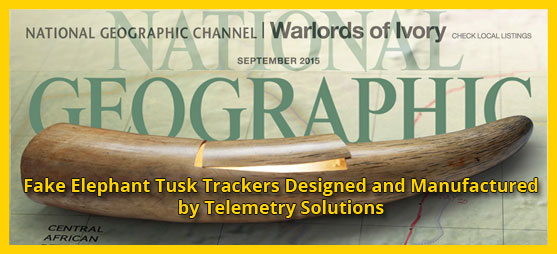National Geographic tracking artificial tusks with the help of Telemetry Solutions
Telemetry Solutions’ Iridium GPS trackers enabled The National Geographic Explorer of the Year and his team to track artificial tusks in the illegal ivory trade

Starting in the spring of 2014, Telemetry Solutions worked closely with a National Geographic team. During that time, we designed and manufactured GPS devices for tracking elephant tusks. Next, these artificial tusks were planted in the southeastern Central African Republic. Soon after, they went directly into the illegal ivory supply chain. Consequently, the elephant tusks were tracked a total distance of 592 miles. This exposed the illegal global ivory trade. Furthermore, it demonstrated how the illegal ivory trade finances terrorist organizations. We could see the daily movement of the artificial tusks since tracking was done in real time.
First of all, National Geographic investigative journalist and Explorer of the Year Bryan Christy contacted Telemetry Solutions. Next, Christy asked if we could design and manufacture GPS trackers for this project. Although he might have found it a far-fetched, incredible thing to ask, it was right in our wheelhouse. Our immediate answer was, “Yes, we can do this.” This is a perfect example of using our various telemetry platforms to satisfy a custom application quickly.
Article: The Problem Solver
“To follow my artificial tusks from the jungle to their final destination, I need a tracking device capable of transmitting exact locations without dead zones. It needs to be durable and small enough to fit inside the cavities George Dante would make in the blocks of resin and lead that formed the tusks.
Quintin Kermeen, 51, based in Concord, California, has the credentials, and the personality, I’m looking for. Kermeen started in the radio-tracking business when he was 15 and has since built electronic trackers and collars for wildlife from Andean bears to California condors to Tasmanian devils. Next, he designed a GPS tracker that the U.S. Geological Survey embedded in live Burmese pythons to monitor the invasive snakes in the Florida Everglades. Kermeen also built GPS satellite collars to enable pest control authorities in New Zealand to send feral pigs into the bush and locate their invasive piggy friends for his Judas pig project. We meet over Skype.
After months of tinkering, Kermeen’s final bespoke ivory-tracking device arrives in the mail. It consists of a battery capable of lasting more than a year, a GPS receiver, an Iridium satellite transceiver, and a temperature sensor” – Bryan Christy National Geographic Magazine September 2015
Read More: National Geographic
Follow the route: National Geographic interactive map
Watch the trailer: Warlords of Ivory
About the GPS artificial tusk trackers
The custom-made trackers were 180 mm. x 53 mm x 29 mm in size since they had to be small. They weighed 97 grams. Most noteworthy, each was configured with a minimum 1-year battery life. Each device allowed the customer to set the GPS schedule. Customers also set the data transmission schedule based on their needs. A web-based interface was used to set these schedules. Then they were transmitted by satellite to the artificial tusks. While they tusks were deployed, schedules were routinely changed by the client.
A satellite (Iridium) transmitted the location data set in each device. GPS position data were posted on a secure website and emailed to The National Geographic Team. Finally, they could track each artificial tusk along the route. Poachers then carried the elephant tusks on their nefarious mission. For more information about this product please watch the video here: Fake elephant tusk tracker made by Telemetry Solutions
![]()
Contact us if you have a funded project like this. Follow Telemetry Solutions on Facebook, Instagram, and YouTube!
